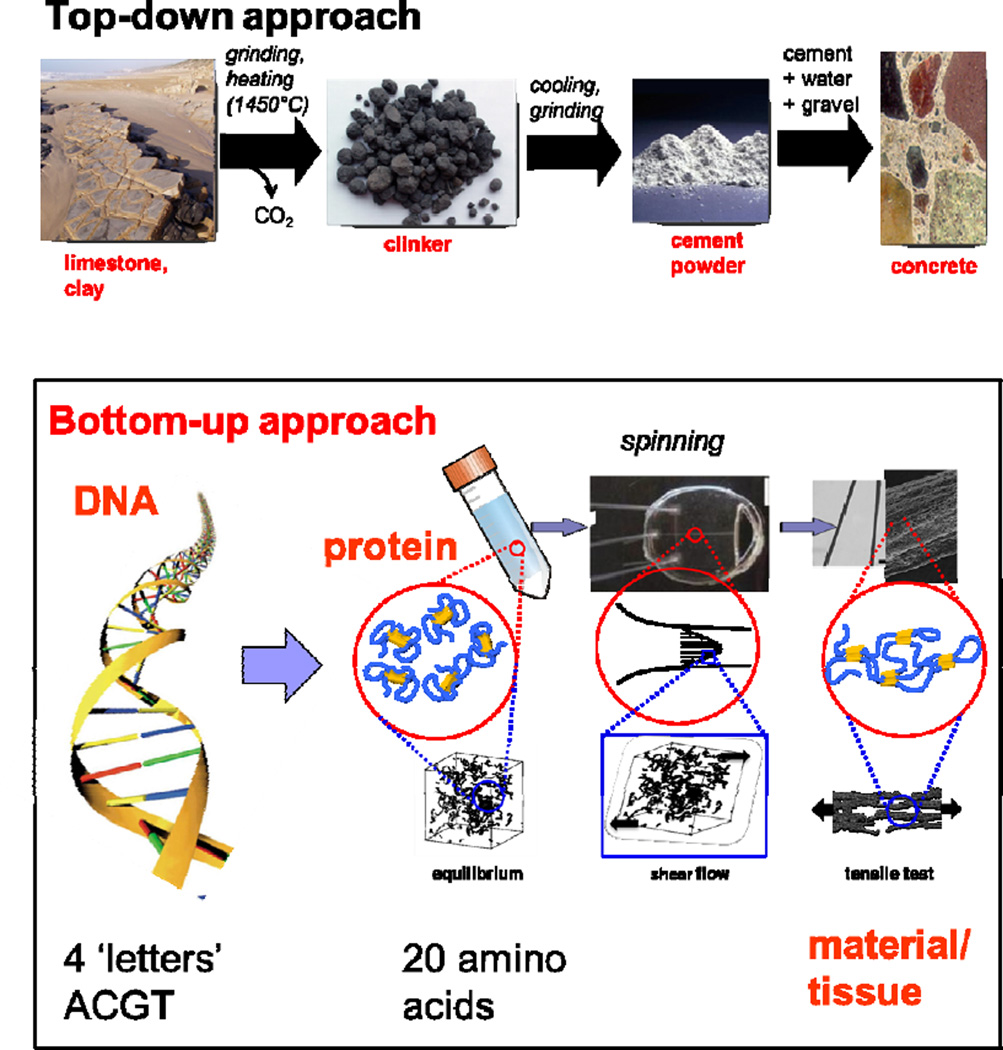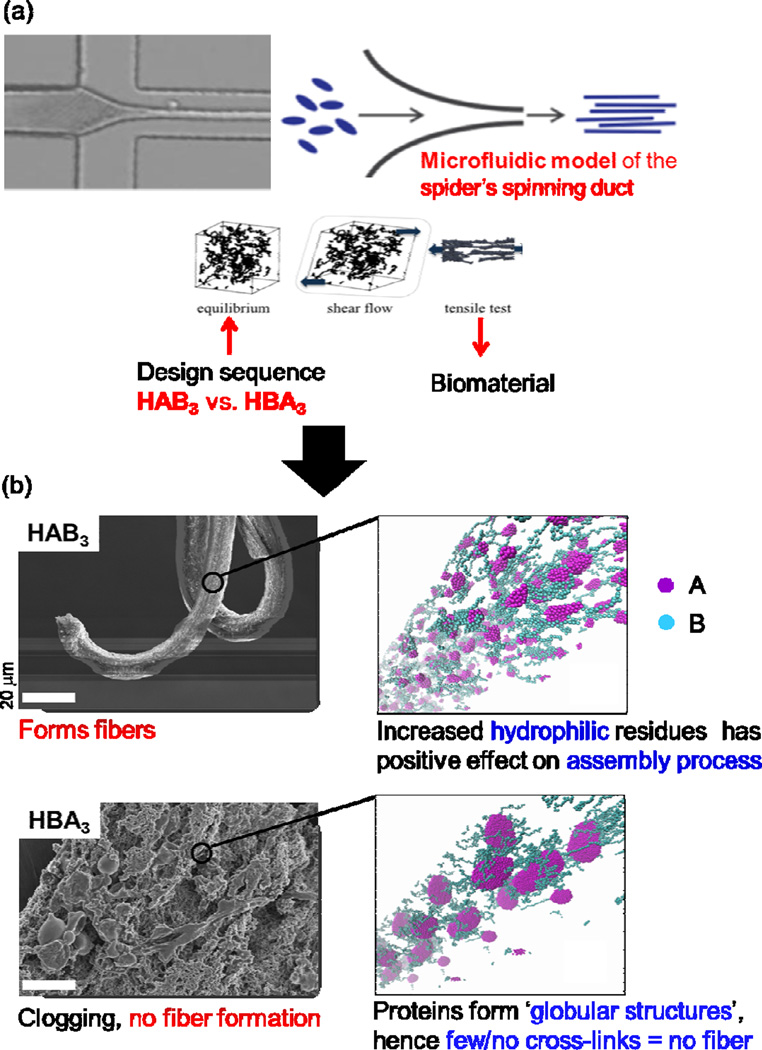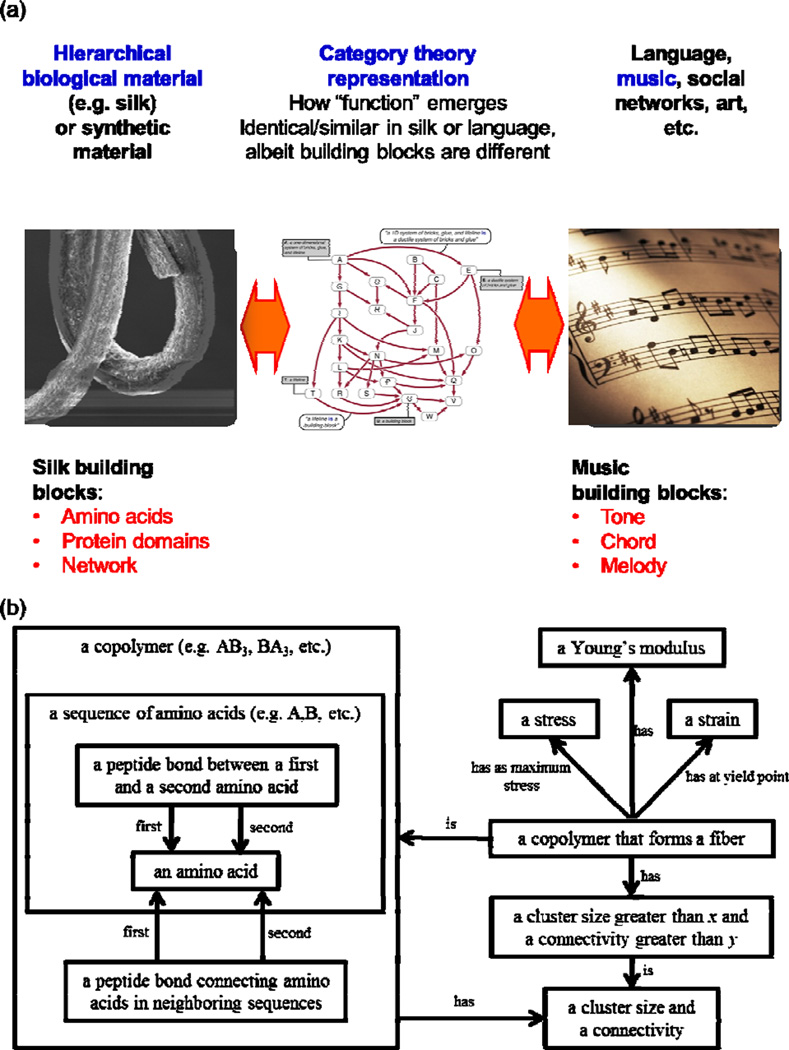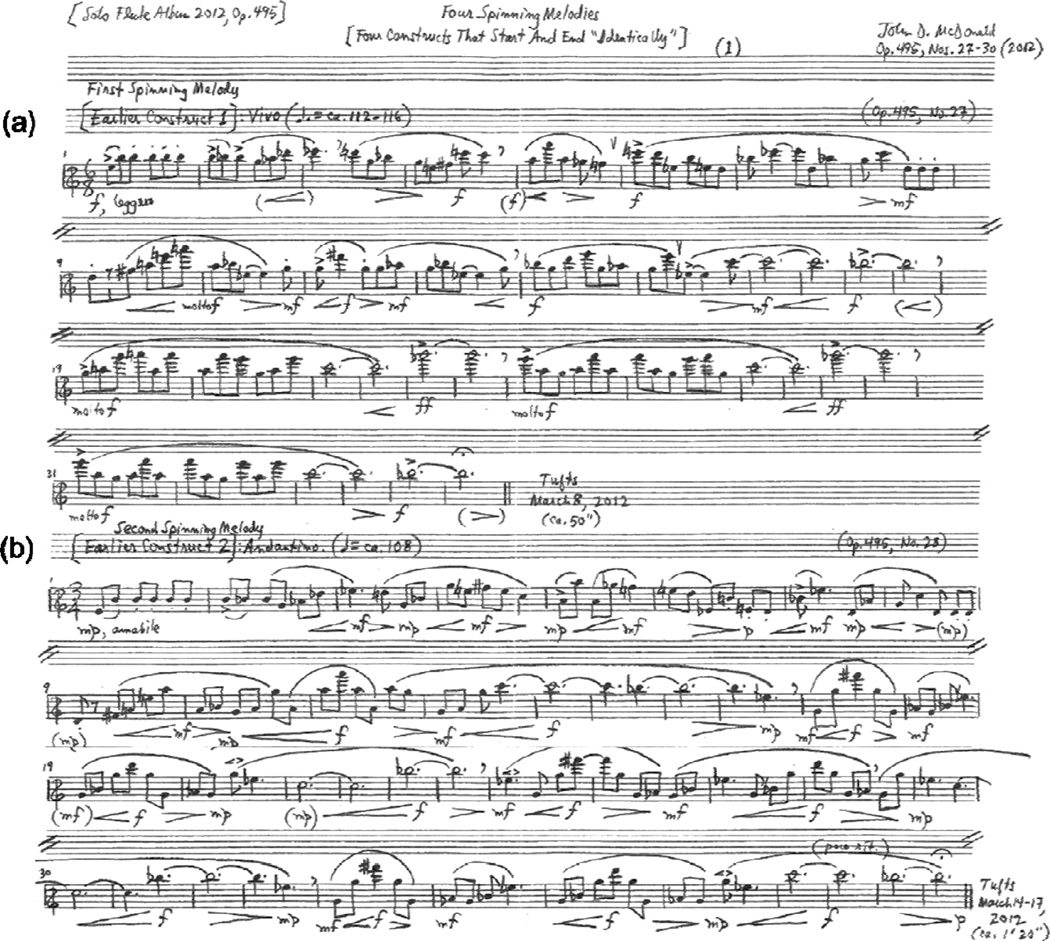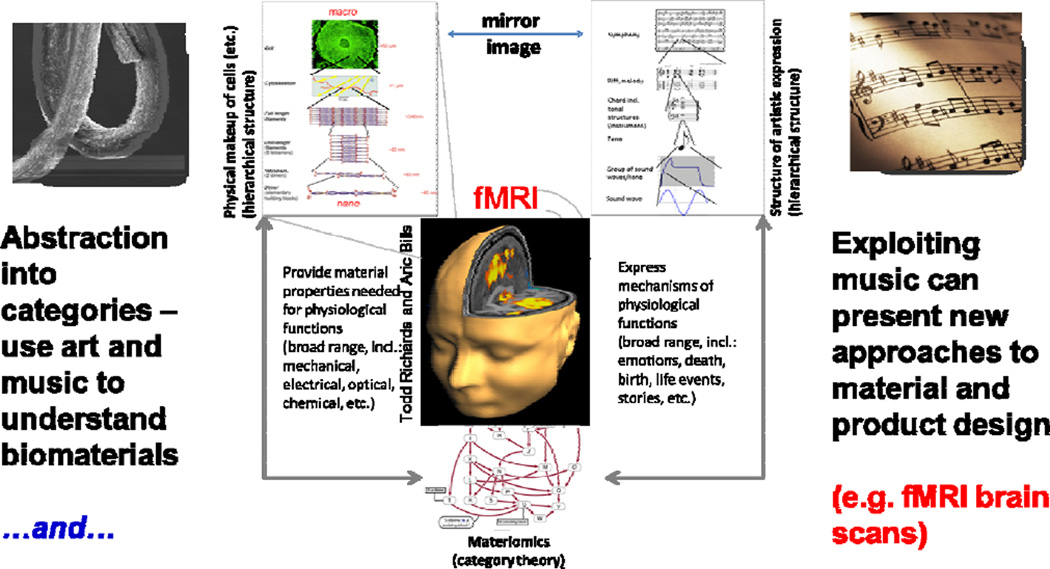Abstract
Tailored materials with tunable properties are crucial for applications as biomaterials, for drug delivery, as functional coatings, or as lightweight composites. An emerging paradigm in designing such materials is the construction of hierarchical assemblies of simple building blocks into complex architectures with superior properties. We review this approach in a case study of silk, a genetically programmable and processable biomaterial, which, in its natural role serves as a versatile protein fiber with hierarchical organization to provide structural support, prey procurement or protection of eggs. Through an abstraction of knowledge from the physical system, silk, to a mathematical model using category theory, we describe how the mechanism of spinning fibers from proteins can be translated into music through a process that assigns a set of rules that governs the construction of the system. This technique allows one to express the structure, mechanisms and properties of the ‘material’ in a very different domain, ‘music’. The integration of science and art through categorization of structure-property relationships presents a novel paradigm to create new bioinspired materials, through the translation of structures and mechanisms from distinct hierarchical systems and in the context of the limited number of building blocks that universally governs these systems.
Keywords: Nanotechnology, biology, music, theory, experiment, arts, design, manufacturing, nanomechanics, protein
INTRODUCTION
As of late we have witnessed remarkable advances in understanding how tunable material properties are achieved in nature and how this knowledge can be exploited in the design of synthetic systems. Here, we focus on silk in order to illustrate that the concepts underlying its materials science and engineering are fundamental unifying factors that link a range of fields of immense fundamental and practical importance defined by the nanoscale properties of protein assemblies – molecular medicine, biomechanics, and functional bionanomaterials [1–11]. Recent breakthroughs promise to change the way materials are designed not only for biomedical applications, but in many other domains of engineering as well through an interdisciplinary approach at the interface of biology, engineering and mathematics [12, 13]. Combining these advances using a systems approach could have major impact for numerous fields in nanotechnology where a central challenge remains the coupling of scales in the design of materials that can be applied to serve critical needs in engineering and medicine with a limited set of building blocks.
FROM THE BOTTOM UP: SPINNING SILK
The bottom-up design of materials opens important opportunities to provide alternative solutions to create function from few raw materials. In contrast to conventional engineering materials such as steel, ceramics or cement – for which different raw materials must be used at the beginning of the production process – materials like those made from proteins provide enhanced flexibility through complex structural organization. A close integration of material synthesis with manufacturing of an integrated device is critical, emphasizing the importance of a holistic systems perspective in the design process. This bioinspired view towards manufacturing is a powerful paradigm to connect the nano- to the macro-scale (Figure 1). Future impact also includes an all-green process used in such bottom-up materials formation, from the aqueous environment to the ambient conditions of assembly – where heightened materials complexity is orchestrated in an organic fashion. There are many challenges in advancing this concept from the idea to the actual manufacturing of a material, but recent process in integrating experiment, theory and simulation provides the necessary tools that form the basis of a systems-based materiomics approach.
Figure 1. Conventional and new material design and manufacturing approaches; here focused on bioinspired protein polymers.
The conventional top-down approach typically requires distinct raw materials for different material properties (e.g.: limestone and clay to make cement, iron ore and carbon to make steel, petroleum to make plastics, etc.). In a bottom-up bioinspired approach, the same set of limited building blocks (DNA, protein, etc.) are used to create many different material functions (e.g.: collagen proteins to make tendon, silk proteins to make cocoons, or elastin and collagen proteins to make skin; whereby all of these are made from the same library of 20 amino acids).
We have recently designed and applied an integrated experimental-computational methodology to design new silk-based materials by engineering the sequence of protein building blocks [14, 15], and preliminary results of these studies are shown in Figure 2. We developed de novo silk sequences based on the naturally occurring features found in silk proteins, synthesized them, and spun them into fibers. Derived from our knowledge of the behavior of natural silk proteins, our sequences contain two major building blocks – “A” (hydrophobic consensus domain, realized as an Ala-rich sequence) and “B” (hydrophilic consensus domain) combined with a hexahistidine tag labeled “H”. The two building blocks represent an abstraction of the characteristic structure of naturally occurring silk, which is a composite made from the repetitive arrangement of hydrophobic and hydrophilic domains [1, 16–18]. Typically, the hydrophobic sequences lead to the formation of very stiff and strong beta-sheet rich regions (e.g. nanocrystals) whereas the hydrophilic sequences lead to the formation of more disorganized, softer and extensible domains [17, 18]. By combining these fundamental building blocks into varied sequences we created synthetic constructs (of the form: HAxBy) that allow us to probe the effect of sequence variations on the properties of protein fibers; and eventually, associated biological properties such as control of cell phenotype and others.
Figure 2. Summary of experimental and computational studies.
(original data from [14, 15]). The integration of experimental work (bioinspired microfluidic technology) with multiscale modeling (coarse-grained model of silk protein) allows one to directly simulate the complex shear-flow driven assembly process, and to gain fundamental insight into the assembly process of bioinspired silk proteins into fibers (panel (a)). Panel (b) shows experimental and computational results from two different protein sequences. The HAB3 sequence forms fibers, whereas the HA3B sequence doesn’t, which could be explained by the computational model [15].
Specifically, we considered two sequences – HA3B and HAB3 in order to examine how the relative amount of hydrophobic versus hydrophilic domains affects the structure and properties of fibers. We have demonstrated both experimentally and computationally that an increasing amount of A in the sequence leads to a stiffer, stronger but less deformable proteins, as evidenced in directly comparing the HA3B case with the HAB3 case [14]. However, even though the protein’s properties are understood, the ability of the protein chains to assemble into larger-scale fibers remains an open question. To address this we used an experimental microfluidic flow focusing approach [4, 19] to mimic the natural process of fiber formation in the insects’ spinning duct. Interestingly, while it performs “better” as an individual protein (stiffer and stronger), we found that the HA3B sequence does not form fibers, whereas the HAB3 sequence does form fibers. The experimental outcome was not intuitively obvious until after the modeling was performed, which provided the mechanistic insight necessary to fully understand the process. The mechanism underlying this difference of behavior could be explained using coarse-grained Dissipative Particle Dynamics (DPD) modeling [15]. We found that in the HA3B case the hydrophobic interactions are very strong, leading to the assembly of many but largely unconnected globular structures, without forming a well-percolated network (Figure 2(b), lower part). In contrast, in the HAB3 case, the protein chains linked up to form a percolating network (Figure 2(b), upper part). Even though the individual HA3B protein sequence featured better properties, it lacked the ability to form a network and hence scaling up its properties to larger length-scales. This is due to the aggressive nature of the A segments such that they agglomerate strongly at a local scale. This combination of experiment and simulation illustrates how complementary insights can be learned from each of the approaches. An integrated experimental-computational system helps to refine each of the approaches, and to this end, we have predicted new sequences that we anticipate will form fibers using the microfluidics technique.
SILK TO MUSIC, DANCE AND BACK
While at first glance, there does not appear to be many similarities between music and biopolymers, as we discuss here, each of these seemingly disparate fields involves hierarchical processes with emergent behavior that have specific relationships between the different length- and time-scales. The question we pose is whether we can develop a systematic approach to store the complex information learned from the physical experiments, simulations and modeling in a concise form and exchange the insight with other fields of science or art? Furthermore, can we identify transformative approaches to the design of novel materials that borrows concepts from different fields, where a systems-level understanding of emergent function is developed? Could we exploit the insights from a composer in constructing music as a hierarchical system in the design of new biomaterials? If successful, such approaches may unleash untapped creative power to advance nanotechnology.
To this end, category theory is a powerful mathematical language and toolset, by which one can codify all interacting components of a system and then study how such systems compare (Figure 3) [20]. By formulating a category, we can understand and reason about a very precise topic even if the subject is quite complex. The ability to clarify and carefully denote the varied sorts of information found in any system is quite useful in our application, in which we must exploit our understanding of hierarchical systems. Once we develop and establish a consistent vocabulary for the system under discussion, we can leverage mathematical theorems to provide insights into the design process from seemingly different fields [21].
Figure 3. Translation from material to music, by categorizing structure-property relationships.
(a), The domains of expression in the silk case are amino acids, protein domains and the resulting network. These expressions are translated to music, where the domains of expression are tones, chords and melodies. The use of category theory helps us to ask the right questions, such as, what would be the critical conditions to achieve a desired functionality in music and materials science, or what would be analogous to fiber formation in a musical piece. (b), Olog for the structural and mechanical properties copolymers that form fibers. This hierarchical material olog builds up copolymers in terms of more basic sequences and based on cluster size (β-sheet crystal size) and connectivity determines their ability to form a fiber. A functorially isomorphic olog could be used to capture similar structural and functional properties in solo musical pieces, as demonstrated in [13].
For example, mathematicians study shapes of all sorts, but to be clear about precisely what is meant by shapes, they may use any of a number of different categories—the category of topological spaces, the category of manifolds, the category of vector spaces, etc.—and each will have its own interesting features and special character. Despite their differences, these categories can be compared and theorems about one category can be lifted to theorems about another. Each of the three categories mentioned above are infinitely large and contain every theoretical example of a certain structure; however, in the application to materials science and music, for example, the categories tend to be much smaller, because we are interested in a finite number of structures and abstractions that we have so-far observed in nature.
Categorizing hierarchical systems: an example
A ‘category’ is a system of objects and arrows, together with a method for traversing multiple arrows. These objects and arrows roughly correspond to abstract structures and their interactions. The arrows are usually called morphisms, roughly meaning shape-preserving transformations. Any person can create a category; there are thousands being discussed every day throughout the world by mathematicians (categories called such things as “ the category of rings” and “the category of partially ordered sets”). A category in which objects and arrows are labeled in a human-readable manner is called an olog [22]. Like a more rigorous version of concept webs, an olog captures and refines the relationships between multiple structures. To encode the notion of hierarchy is even more interesting. A hierarchical system is one in which an abstract object may be entirely composed of a system of constituent objects and hence display aggregate properties of that system. One can use hierarchical categories and ologs to encode such structures. In a hierarchical olog, an object X may exist as a frame around a sub-olog, called its constituency. This frame corresponds to a certain mathematical structure, which ensures that the framing object X is indeed hierarchically composed of the specified arrangement of constituent objects. An example of such a hierarchical category is depicted in Figure 3(b).
Spinning melodies
As reviewed above, patterns of structure at certain length- and time-scales govern the assembly and properties of bioinspired silk fibers, and experiment and simulation can be effectively combined to understand the behavior of these systems. Now, the same sequences that were spun in the microfluidic device (see results depicted in Figure 2) were used to compose melodies inspired by silk, by translating between the two systems (Figure 3). Excerpts of the composed melodies are shown in Figure 4. The melodies were written for flute, chosen for its clarity of tone. We have scored the melodies in a mode one of the co-authors has used earlier for compiling ‘albums’ of solo flute miniatures. In this composition, the melodies were constructed according to a set of rules that reflect the behavior of the material (silk) in a different domain (music) (see Supplementary data).
Figure 4. Excerpts from the compositions corresponding to the two silk sequences studied; HAB3 (a) and HA3B (b).
Panel (a) shows the scores of “01 Spinning Melody 1_ Vivo.mp3” and panel (b) shows the scores of “02 Spinning Melody 2_ Andantino.mp3”. The complete set of four audio samples can be found online (see Supplementary data). Note the aggressive aspects of files 2 and 4 (“non-fiber-forming melodies”), and the “gentler,” “shapelier” aspects of files 1 and 3 (“fiber-forming melodies”).
Others have made similar compositions in which specific pitches (notes) are mapped to specific amino acids of a protein sequence [23]. However, what we propose here goes beyond the simple mapping. Through the development of ologs between music and materials or between dance and materials, a systematic approach for this translation can be established, and we can create novel music or dance that present implications for future approaches to making materials. In our study we created four musical pieces (audio files included as Supplementary data):
01 Spinning Melody 1_ Vivo.mp3: HAB3 Melody 1: forms fibers
02 Spinning Melody 2_ Andantino.mp3: HA3B Melody 1: doesn’t form fibers
03 Spinning Melody 3_ Vivo.mp3: HAB3 Melody 2: forms fibers (longer than Melody 1)
04 Spinning Melody 4 Andantino; Bright.mp3: HA3B Melody 2: doesn’t form fibers (longer than Melody 2)
The four melodies spin out in about seven minutes when performed in their entirety. The post-performance analysis of the pieces gives interesting insight when comparing the music system with the silk system. HAB3, the successful construct that forms fibers, includes many more repetitions of the “B-block”, which is more shapely and internally differentiated in the music (more lyrical) than the “A-block” (more ritualistic and aggressive). The more aggressive music apparently indicates the assembly of many but unconnected globular structures, without forming a percolated network (Figure 2(b), lower part). This agrees with the observation in the protein case, where the intuitive trend would be to consider the HA3B sequence to be better; however, the aggressive nature of the A segments to agglomerate rather strongly (at a local scale) leads to a lack of the overall system to form a better connected fiber (Figure 2(b), upper part). In contrast, the other music allows for the whole piece to form an integrated structure – in analogy to ability of that protein to form a fiber. We note that this is not to say that one piece is more aesthetically “successful” than another, but that a certain musical character may be said to be more conducive to forming fiber than another. Understanding these relationships from one domain to another and vice versa may eventually help us in using existing or new musical pieces in order to improve the design of materials.
Exciting opportunities open with regards to the translation from music to materials design – for example, can we use Beethoven’s symphonies to inform the development of a new nanomaterial by translating musical patterns into protein sequences, mechanisms and processing conditions? Music, if considered an inherent part of us, could be an expression of the structure of our brain, tissues, organs etc. and thereby serve as a new type of “microscope” to understand biological processes (Figure 5) [24]. In this context the development of quantitative approaches to measure the effect of music on the brain could be important, and may be achieved by using techniques such as fMRI to assess the connectivity of how one perceives the music, including the quantification of mechanisms. In such an experiment, a person would listen to the four sequences composed here and we would identify whether or not physiological effects in the brain’s activity can be correlated with the physical process of spinning fibers from protein solutions. The translation of proteins is not limited to music, but one can imagine a similar approach being applied to other expressions of art such as dance, or painting.
Figure 5. Why music is part of us.
(figure adapted from [24]). Music is an expression of our body’s materials (e.g. proteins, tissues, etc.) in a different manifestation. Exploiting this concept may enable us to identify new avenues to understand the functioning of biomaterials through the study of art such as music, dance or literature. What’s more, they may provide revolutionary insights into the design of materials. The fMRI scans can be used to quantify the ‘connectivity’ of the music as perceived by a human subject and to identify associated mechanisms.
CONCLUSION
Using a limited palette of simple building blocks and requiring less energy and fewer materials, a major goal of the approach reviewed here is to achieve functional diversity of sustainable materials. How does one make functionally more complex materials from simple building blocks? Functional diversity does not necessarily require diverse building blocks: in protein engineering, we have a limited set of amino acid sequences; in music, limited musical instruments, tones, rhythms, and ranges and in in dance, limited types of movements. By using simple building blocks, we are limiting the number of starting materials; thus, we can reduce manufacturing costs and increase sustainability. However, in protein and biopolymer design, we can achieve diversity by varying peptide sequence or length. A similar approach could be applied to other expressions of art, such as dance. In dance, we can diversify the basic gesture building block by varying the timing, space, and energy (e.g., quick vs. slow step), where the focus is on the intent to tell a story or create a visual image or design. In musical composition, we have a limited range of notes and instruments we can vary with timing and volume (e.g., crescendo or diminuendo). We envision that such expressions may further the range of applications and creative processes in nanomaterials design and nanotechnology in general.
Supplementary Material
Tailored materials with tunable properties are crucial for applications as biomaterials
Hierarchical assemblies of simple building blocks into complex architectures leads to superior materials.
Through an abstraction of knowledge from silk we describe how the mechanism of spinning fibers from proteins can be translated into music
We express the structure, mechanisms and properties of the ‘material’ in a very different domain, ‘music’
The integration of science and art through categorization of structure-property relationships presents a novel paradigm to design materials
Acknowledgements
We acknowledge support from NIH (U01 EB014976), NSF (CAREER 0642545 and CBET 1067093), ONR (PECASE N00014-10-1-0562), and AFOSR (FA9550-11-1-0199).
Footnotes
Publisher's Disclaimer: This is a PDF file of an unedited manuscript that has been accepted for publication. As a service to our customers we are providing this early version of the manuscript. The manuscript will undergo copyediting, typesetting, and review of the resulting proof before it is published in its final citable form. Please note that during the production process errorsmaybe discovered which could affect the content, and all legal disclaimers that apply to the journal pertain.
REFERENCES
- 1.Omenetto F, Kaplan D. From Silk Cocoon to Medical Miracle. Scientific American. 2010;303(5):76–77. [PubMed] [Google Scholar]
- 2.Omenetto FG, Kaplan DL. New Opportunities for an Ancient Material. Science. 2010;329(5991):528–531. doi: 10.1126/science.1188936. [DOI] [PMC free article] [PubMed] [Google Scholar]
- 3.Cranford SW, Tarakanova A, Pugno NM, Buehler MJ. Nonlinear material behaviour of spider silk yields robust webs. Nature. 2012;482(7383):72–U91. doi: 10.1038/nature10739. [DOI] [PubMed] [Google Scholar]
- 4.Kinahan ME, Filippidi E, Koster S, Hu X, Evans HM, Pfohl T, Kaplan DL, Wong J. Tunable Silk: Using Microfluidics to Fabricate Silk Fibers with Controllable Properties. Biomacromolecules. 2011;12(5):1504–1511. doi: 10.1021/bm1014624. [DOI] [PMC free article] [PubMed] [Google Scholar]
- 5.Buehler MJ. Tu(r)ning weakness to strength. Nano Today. 2010;5(5):379–383. [Google Scholar]
- 6.Fratzl P, Weinkamer R. Nature's hierarchical materials. Progress in Materials Science. 2007;52(8):1263–1334. [Google Scholar]
- 7.Liu KS, Jiang L. Bio-inspired design of multiscale structures for function integration. Nano Today. 2011;6(2):155–175. [Google Scholar]
- 8.Humenik M, Scheibel T, Smith A. Spider Silk: Understanding the Structure-Function Relationship of a Natural Fiber. Progress in Molecular Biology and Translational Science, Vol 103: Molecular Assembly in Natural and Engineered Systems. 2011;103:131–185. doi: 10.1016/B978-0-12-415906-8.00007-8. [DOI] [PubMed] [Google Scholar]
- 9.Heim M, Romer L, Scheibel T. Hierarchical structures made of proteins. The complex architecture of spider webs and their constituent silk proteins. Chemical Society Reviews. 2010;39(1):156–164. doi: 10.1039/b813273a. [DOI] [PubMed] [Google Scholar]
- 10.Sutherland TD, Weisman S, Walker AA, Mudie ST. Invited Review The Coiled Coil Silk of Bees, Ants, and Hornets. Biopolymers. 2012;97(6):446–454. doi: 10.1002/bip.21702. [DOI] [PubMed] [Google Scholar]
- 11.Blackledge TA. Spider silk: a brief review and prospectus on research linking biomechanics and ecology in draglines and orb webs. Journal of Arachnology. 2012;40(1):1–12. [Google Scholar]
- 12.Gronau G, Kinahan ME, Krishnaji ST, Giesa T, Kaplan D, Wong JY, Buehler MJ. A review of combined experimental and computational procedures for assessing biopolymer structure-process-property relationships. Biomaterials. 2012 doi: 10.1016/j.biomaterials.2012.06.054. [DOI] [PMC free article] [PubMed] [Google Scholar]
- 13.Giesa T, Spivak D, Buehler MJ. Reoccurring Patterns in Hierarchical Protein Materials and Music: The Power of Analogies. BioNanoScience. 2011;1(4):153–161. [Google Scholar]
- 14.Krishnaj ST, Bratzel G, Kinahan ME, Kluge JA, Staii C, Wong JY, Buehler MJ, Kaplan DL. Sequence–structure–property relationships of recombinant spider silk proteins: Integration of biopolymer design, processing, and modeling. Advanced Functional Materials. 2012 in press. [Google Scholar]
- 15.Rye S, Gronau G, Kinahan ME, Krishnaji ST, Kaplan D, Wong JY, Buehler MJ. Structure and mechanical properties of silk-inspired flow-assembled fibers: Modeling and experiment. 2012 in submission. [Google Scholar]
- 16.Kaplan D, Adams WW, Farmer B, Viney C. Silk - Biology, Structure, Properties, and Genetics. Silk Polymers. 1994;544:2–16. [Google Scholar]
- 17.Keten S, Buehler MJ. Nanostructure and molecular mechanics of spider dragline silk protein assemblies. Journal of the Royal Society Interface. 2010;7(53):1709–1721. doi: 10.1098/rsif.2010.0149. [DOI] [PMC free article] [PubMed] [Google Scholar]
- 18.Nova A, Keten S, Pugno NM, Redaelli A, Buehler MJ. Molecular and Nanostructural Mechanisms of Deformation, Strength and Toughness of Spider Silk Fibrils. Nano Letters. 2010;10(7):2626–2634. doi: 10.1021/nl101341w. [DOI] [PubMed] [Google Scholar]
- 19.Rammensee S, Slotta U, Scheibel T, Bausch AR. Assembly mechanism of recombinant spider silk proteins. Proceedings of the National Academy of Sciences of the United States of America. 2008;105(18):6590–6595. doi: 10.1073/pnas.0709246105. [DOI] [PMC free article] [PubMed] [Google Scholar]
- 20.Mac Lane S. Categories for the working mathematician. New York: Springer; 1998. [Google Scholar]
- 21.Giesa T, Spivak D, Buehler M. Category Theory Based Solution for the Building Block Replacement Problem in Materials Design. Advanced Engineering Materials. 2012 [Google Scholar]
- 22.Spivak DI, Kent RE. Ologs: a categorical framework for knowledge representation. PLoS One. 2012;7(1):e24274. doi: 10.1371/journal.pone.0024274. [DOI] [PMC free article] [PubMed] [Google Scholar]
- 23.Takahashi R, Miller JH. Conversion of amino-acid sequence in proteins to classical music: search for auditory patterns. Genome Biol. 2007;8(5):405. doi: 10.1186/gb-2007-8-5-405. [DOI] [PMC free article] [PubMed] [Google Scholar]
- 24.Cranford SW, Buehler MJ. Biomateriomics. 1st ed. New York: Springer; 2012. [Google Scholar]
Associated Data
This section collects any data citations, data availability statements, or supplementary materials included in this article.



